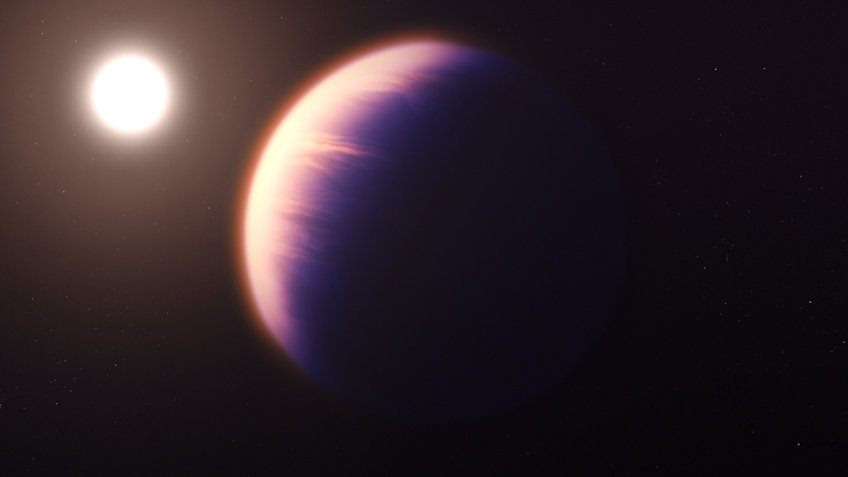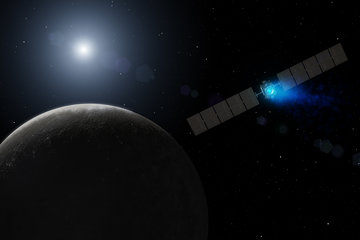Exoplanets in the zoom of the Webb Telescope
The observatory shows atmosphere properties in more detail than ever before
Observations of the exoplanet WASP-39b with the James Webb Space Telescope (JWST) have yielded a wealth of information about the planet’s atmosphere – a whole new level of observational data, and a harbinger of how JWST will shape the study of exoplanet atmospheres in the future. The detailed infrared spectra taken with three of JWST’s four instruments contain information about atmospheric chemistry of unprecedented accuracy, allow deductions about the planet’s cloud cover, and include the first signs of photochemistry in exoplanet atmospheres. Data about the chemical composition is so accurate as to allow for deductions about the planet's formation.

Information about clouds, first data about photochemistry, and a near-complete chemical inventory that hints at the planet's formation history – those are some highlights from the recently published observations of the exoplanet WASP-39b with the James Webb Telescope (JWST). “Data like these are a game changer,” is the verdict of Natalia Batalha (University of California at Santa Cruz), who coordinated the observing program that yielded the new results. The new results, by a group of astronomers that includes MPIA director Laura Kreidberg, also showcase methods that, eventually, should allow astronomers to detect life on distant planets, although that will be a job for one of the successors of JWST.
The launch of the JWST on 25 December 2021 sent waves of excitement through the astronomical community. The first images and spectra, published in mid-July 2022, raised expectations even higher, showing as they did just how far JWST could go beyond previously available infrared telescopes when it came to finest details, to the telescope's reach in imaging some of the most distant objects in the Universe, and the data quality for brightness measurements and the determination of astronomical spectra – the rainbow-like decompositions of astronomical objects’ light that contain a wealth of information about the objects’ motions, chemical composition or temperatures.
But for astronomers planning their own observations, the information contained in those first pictures was of course not nearly enough. For them, JWST started to be put through its paces immediately afterwards, during the first five months of JWST's science operations, in the shape of the “Early Release Science Programs”: 13 observational programs covering a representative sample of targets from solar-system objects to the most distant galaxies, chosen specifically so as to give observational astronomers all the information they would need to make optimal use of JWST’s instruments themselves later on. Data from those programs is released to the astronomical community directly after the observations are complete. They are complemented by “guide books” and additional analysis aimed at making future observational planning as effective as possible.
All eyes on WASP-39b
Now, a series of five articles allows astronomers to witness the observing power of the fully commissioned and calibrated JWST when it comes to the atmospheres of exoplanets – planets around stars other than the Sun. The observations are part of the “Transiting Exoplanet Community Early Release Science Program” led by Batalha, and focus on the planet WASP-39b: a fluffy version of our own Solar System’s Saturn (although we have no idea whether it might have rings), which orbits a star that has just a bit less mass than the Sun. The whole system is at a distance of about 700 light-years from Earth.
Crucial for the observations in this case are so-called exoplanet transits. Such a transit happens when from the point-of-view of observers here on Earth, a planet orbiting a distant star passes between that star and us. Exoplanets are typically too far away for us to see in detail how the little dark disk of the planet passes in front of the bright disk of the star. What can be observed are brightness variations. After all, the planet moves in front of the star and, in doing so, blocks some of the starlight. The astronomers made use of JWST to observe four different transits from mid to late July 2022, using three of the space telescope's four science instruments: NIRCam and NIRISS for one transit each, and two transits observed with two different operational modes of NIRSpec, respectively. MPIA has a direct connection to the hardware in use here, as well: as part of a European consortium, the institute supplied the mechanisms of the filter and grating wheels that NIRSpec uses to split the light into the various wavelengths.
Transit spectroscopy

There is an additional twist to the brightness variations. WASP-39b has a comparatively thick atmosphere. If you could see the details of the planet’s disk silhouetted against the bright star during a transit, you would see the dark disk, surrounded by a thin colored ring that represents starlight filtered through the planet’s atmosphere.
This means that the dimming of starlight is now color-dependent, or in terms of the underlying physics: it depends on the wavelength of light at which we observe the system. If the detailed view (which we do not, in reality, have) were to show a dark disk surrounded by a thin blue ring of planetary atmosphere, that means blue light could pass through the atmosphere, but red light could not – hence, when observed through a red filter, the starlight's dimming would be more pronounced than through a blue filter.
JWST does not, in studies like the present one, observe the transit through filters, but instead uses spectroscopy to observe the transit in each elementary color, in each wavelength region, separately, with the degree of dimming (“transit depths”). The results are recorded for a broad range of infrared wavelengths.
By comparing their spectroscopic observations with models of the planet's atmosphere, the astronomers were able to extract a wealth of information. The first was a detailed roster of specific molecules that are present in the atmosphere. In August, the team had already published its findings of carbon dioxide in WASP-39b’s atmosphere, the first certain detection of this molecule in an exoplanet atmosphere.
The papers published now add a number of crucial additional pieces of the puzzle. A back-then somewhat mysterious spectral feature in the spectrum turned out to represent sulfur dioxide – once more, the first such detection in an exoplanet atmosphere. This opens up the exciting new field of exoplanet photochemistry: Sulfur dioxide molecules, similar to ozone in Earth’s atmosphere, are formed as the upper reaches of the exoplanet's atmosphere interact with high-energy photons from the host star. The fact that WASP-39b is so close to its host star (one eighth the distance from Mercury to our Sun!) makes it an ideal laboratory for exploring these reactions.
Some of the information allows deductions about the planet’s formation. Specifically, the ratios of carbon to oxygen, potassium to oxygen, and sulfur to hydrogen, indicate a formation history where smaller precursor bodies (“planetesimals”) collided with each other and merged to create the present rather large planet. The carbon-oxygen ratio in particular, with oxygen much more abundant than carbon, suggests that WASP-39b initially formed much further away from its star than its present close orbit.
The comparison of observations and models also yielded information about the planet’s cloud cover: a broken-up collection of clouds – not water clouds, though, but clouds made of substances like sulphides and silicates – rather than a single, uniform blanket over the planet.
The observations have already shown the astronomers a more detailed view of an exoplanet atmosphere than ever before, hinting at a lot more discoveries yet to come. And more specifically, of course, the program is meant to facilitate such future discoveries. To this end, the astronomers are providing a data analysis recipe for their dataset, and document their experience with the JWST as used in this particular observation mode extensively, all so as to allow others in the field to follow in their footsteps, and use JWST for transit observations of this kind.
MPIA director Laura Kreidberg, who is a member of the Transiting Exoplanet Community Early Release Science Program, emphasizes that this is indeed just the beginning: “These early observations are a harbinger of more amazing science to come with JWST. We put the telescope through its paces to test the performance, and it was nearly flawless — even better than we hoped.”
The long-term relevance for the search for life on other planets
The current observations are also relevant for one of the greatest future goals of observational astronomy: detecting traces of life on exoplanets. As currently envisioned, the discovery of life on an exoplanet would proceed along very similar lines as the research described here: detailed transit observations by some space telescope that is a successor to JWST would be used to extract data about the exoplanet's atmosphere. A comparison with atmospheric models would eventually show that a certain combination of properties – an excess of atmospheric oxygen, say – strongly indicates the presence of specific kinds of living organisms on that planet.
The observations described here provide a test run for the observational techniques that will need to be employed in this kind of search for life on other planets. They also add important pieces of information to the more complete understanding of exoplanet atmospheres that is needed for future to be able to distinguish between chemistry in exoplanets with and without the involvement of living organisms.
MP/MN













